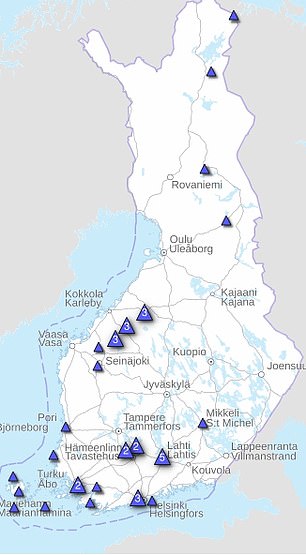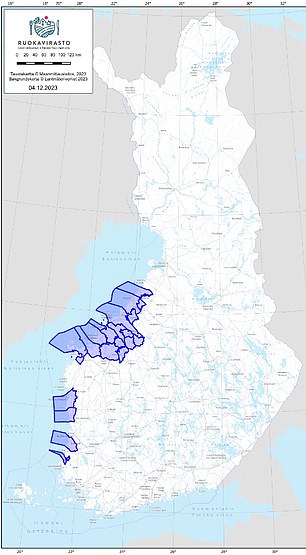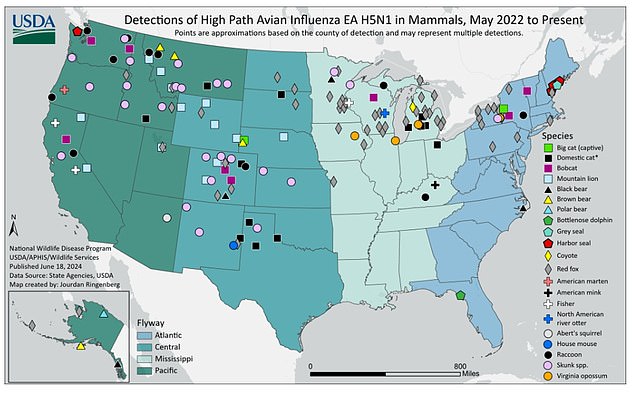Finland will become the first country to offer bird flu vaccines as it plans to give them to high-risk workers next week amid growing concerns about the virus jumping from animals to people.
Authorities in the Nordic nation say 10,000 doses will be given to those who work closely with animals, such as poultry and fur farm workers.
Patients will receive two doses of the shot at least a week apart, and the vaccines will be distributed once they arrive from stockpiles in central Europe.
The bird flu virus is not currently well adapted to infect people, and the CDC says the risk to humans is “low,” but experts fear this could change if it undergoes new mutations, saying each additional infection outside of birds represents a risk.
Globally, at least 11 people have tested positive for bird flu in four countries so far this year. Cambodia has the most cases, with five, followed by three in the United States, which is currently experiencing a major outbreak of bird flu among cows.
No human infections have been reported in Finland so far.
The map above shows detections of avian flu or H5N1 among mammals in the US from May 2022 to June 18, 2024.


LEFT: Wild birds that tested positive for bird flu in 2023. RIGHT: Map of areas where mink farms were found to have bird flu infection
But the country ordered its implementation after an outbreak of the virus at 27 fur farms in the country last year, including those that house mink and foxes.
Although no humans were infected by the virus, cases led to the culling of 485,000 animals to stop the spread of the disease.
In its campaign, Finland will offer a vaccine aimed at H5 protein in the virus, which officials say will likely work well against H5N1 infections.
The vaccines will be shipped by Australian company CSL Seqirus as part of a European Union campaign to acquire 40 million doses in 15 countries.
The Finnish Institute for Health and Welfare (THL) said in a statement: “The vaccine will be offered to people over 18 years of age who are at increased risk of contracting avian influenza due to their work or other circumstances.”
This includes those who work on fur and poultry farms, as well as laboratory technicians who handle bird flu samples and veterinarians who work in areas with fur farms.
The vaccine will also be offered to people who work in sanctuaries caring for wild birds, on farms or those who clean slaughterhouses and animal housing.
If a human infection is detected, the vaccine will also be administered to the person’s close contacts, officials added.
Health officials say the vaccine is expected to generate enough antibodies to protect against a bird flu infection.
An earlier study involving 3,400 people found that 90 percent of those under 60 and 80 percent of those over 60 had antibody levels that “would protect them against H5N1.” Studies have also shown that the vaccine is safe to use.
In the United States, a total of 4.8 million doses of a bird flu vaccine are expected to be delivered by the end of summer, although there are currently no plans to distribute them.
The U.S. Department of Agriculture reports that 118 dairy cow herds in 12 states have confirmed cases of H5N1, and all three human cases were in people who had direct contact with infected cattle.
They experienced eye swelling and respiratory symptoms.
Despite the spread, the CDC said the risk to humans is low.
The outbreak in livestock is unprecedented and has raised concerns that the virus could be one step closer to spreading to humans.
But H5N1 has been causing a major outbreak in the animal world for months, infecting everything from foxes to raccoons and even dolphins and seals.
Finnish officials said they want to roll out the vaccine as soon as possible to minimize the risk of bird flu spreading to humans.
They said the country faces a higher risk because most of its fur farms are outdoors, where animals kept there can come into contact with wild animals, increasing the risk of contracting the virus and transmitting it to humans. .
Minks pose a particular risk because the animals carry receptors similar to those in humans in their lungs, meaning they could act as “mixing vessels” to transmit the virus to humans.


